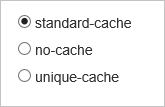Control Azure Content Delivery Network caching behavior with query strings - premium tier
Overview
With Azure Content Delivery Network, you can control how files are cached for a web request that contains a query string. In a web request with a query string, the query string is that portion of the request that occurs after a question mark (?). A query string can contain one or more key-value pairs, in which the field name and its value are separated by an equals sign (=). Each key-value pair is separated by an ampersand (&). For example, HTTP://www.contoso.com/content.mov?field1=value1&field2=value2. If there is more than one key-value pair in a query string of a request, their order does not matter.
Important
The standard and premium content delivery network products provide the same query string caching functionality, but the user interface is different. This article describes the interface for Azure CDN Premium from Edgio. For query string caching with Azure Content Delivery Network standard products, see Control Azure Content Delivery Network caching behavior with query strings - standard tier.
Three query string modes are available:
standard-cache: Default mode. In this mode, the content delivery network point of presence (POP) node passes the query strings from the requestor to the origin server on the first request and caches the asset. All subsequent requests for the asset that are served from the POP server ignore the query strings until the cached asset expires.
Important
If token authorization is enabled for any path on this account, standard-cache mode is the only mode that can be used.
no-cache: In this mode, requests with query strings are not cached at the content delivery network POP node. The POP node retrieves the asset directly from the origin server and passes it to the requestor with each request.
unique-cache: In this mode, each request with a unique URL, including the query string, is treated as a unique asset with its own cache. For example, the response from the origin server for a request for example.ashx?q=test1 is cached at the POP node and returned for subsequent caches with the same query string. A request for example.ashx?q=test2 is cached as a separate asset with its own time to live setting.
Important
Do not use this mode when the query string contains parameters that will change with every request, such as a session ID or a user name, because it will result in a low cache-hit ratio.
Changing query string caching settings for premium content delivery network profiles
Open a content delivery network profile, and then select Manage.

The content delivery network management portal opens.
Hover over the HTTP Large tab, then hover over the Cache Settings flyout menu. Click Query-String Caching.
Query string caching options are displayed.

Select a query string mode, and then select Update.
Important
Because it takes time for the registration to propagate through the content delivery network, cache string settings changes might not be immediately visible. Propagation usually completes in 10 minutes.
Feedback
Coming soon: Throughout 2024 we will be phasing out GitHub Issues as the feedback mechanism for content and replacing it with a new feedback system. For more information see: https://aka.ms/ContentUserFeedback.
Submit and view feedback for